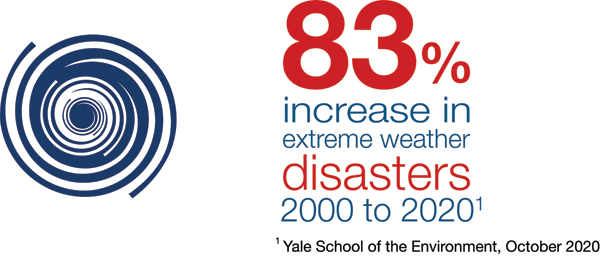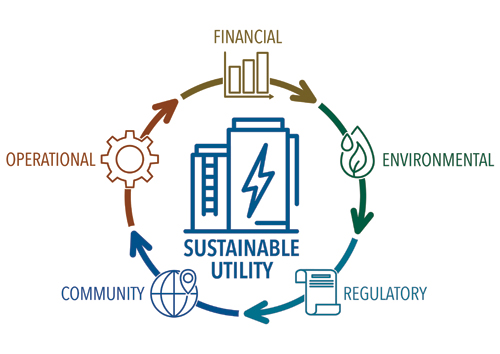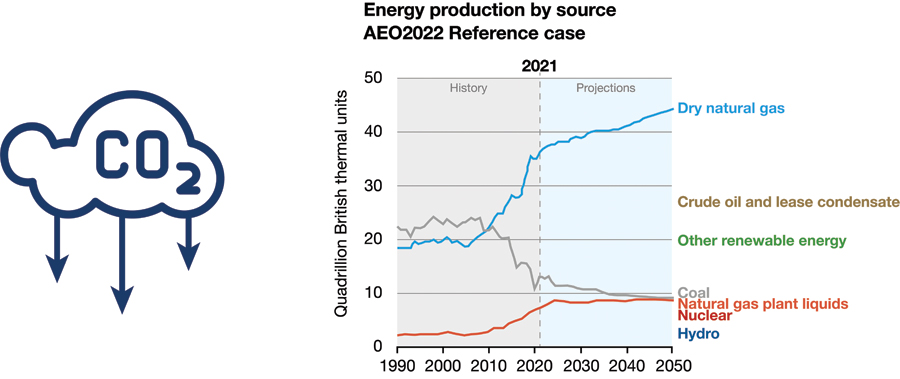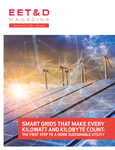For the Grid Transformation Forum, we are pleased to feature Pete Londa, CEO of Tantalus Systems, who explains why, if they are going to become truly sustainable, utilities must be ready to address the collision of the 'electrification of everything' and the 'decarbonization of everything.'
Utilities of all shapes and sizes play an increasingly vital role in addressing the environmental challenges facing our world. They’re under increasing pressure to be more resilient in the face of extreme weather events and to help their local communities become safer and more desirable places to live and work. But addressing these challenges is becoming increasingly difficult to accomplish as we seek to electrify everything while simultaneously decarbonizing everything.
That’s why the utility of the future will need to work with data as much as it works with electricity. A truly sustainable utility needs to know what’s happening at every touchpoint across the distribution grid, from its headquarters to devices located behind the meter. It has to make every kilowatt and every corresponding kilobyte count. And that can only happen when utilities harness a robust and interoperable smart grid — the vital foundation of a modernized and truly digital distribution grid. By deploying a smart grid, a utility can access and leverage data to reduce greenhouse gas (GHG) emissions, integrate sustainable technologies and mitigate the effects of extreme weather.
The world is changing
Utilities face two colliding trends — the Electrification of Everything and the Decarbonization of Everything. Electrification is plain to see wherever we look — electric vehicle (EV) adoption, online shopping, cloud computing, blockchain and an increasing number of embedded computer chips in every device — virtually every aspect of daily life is becoming electrified and connected. Because of expected EV adoption rates, it is estimated that U.S. power production will need to double by 2050.
At the same time, decarbonization is driven by government policy, increasing regulations and consumer demand. Communities are investing more in renewable energy and trying to move away from fossil fuels and coal. In addition, the adoption of distributed energy resources (DERs), such as rooftop solar, home battery storage and microgrids are putting more strain on a grid that is already outdated and in dire need of modernization. And although electrification and decarbonization can be seen as complementary — as in the case of EVs — the fact that these two trends are happening now has utilities caught in the middle of their mutual demands on the flow of power.
 Meanwhile, Mother Nature is serving up increasingly volatile and extreme weather events. We see it every season of every year, with colorful and hard-to-forget names — the Texas Deep Freeze, the California Wildfires, the Heat Dome, the Superstorm, etc. It will only get more intense. Wildfires, hurricanes, heatwaves, winter storms and other extreme weather events are impacting the electric grid on a global scale, resulting in an increasing number of outages that threaten lives and livelihoods. With an 83% increase in extreme weather disasters from 2000 to 2020, grid resilience has never been more important, nor requires more data-driven visibility, command and control at the edge.
Meanwhile, Mother Nature is serving up increasingly volatile and extreme weather events. We see it every season of every year, with colorful and hard-to-forget names — the Texas Deep Freeze, the California Wildfires, the Heat Dome, the Superstorm, etc. It will only get more intense. Wildfires, hurricanes, heatwaves, winter storms and other extreme weather events are impacting the electric grid on a global scale, resulting in an increasing number of outages that threaten lives and livelihoods. With an 83% increase in extreme weather disasters from 2000 to 2020, grid resilience has never been more important, nor requires more data-driven visibility, command and control at the edge.
The combined pressure of these forces — electrification, decarbonization and extreme weather — is something the traditional distribution grid was never designed to handle. That’s why so many utilities are investing in a new model of true sustainability — a model that operates on the foundation of a robust smart grid network capable of supporting the next generation of AMI and the necessary connectivity to and control of DERs and EVs.
A truly sustainable industry
Increased demand for power. A reduced ability to increase capacity to match that demand. New consumption patterns and consumer-generated power at the edge of the grid. A world that is becoming more volatile with each passing year. These are just a few examples of what utilities need to address today and in the future. There is no room for waste. There will be no surplus, and there is less room for error in the face of an emergency.
Utilities must not only become truly sustainable in the face of all this change but they also must become innovative change agents themselves.
The utility of the future needs to achieve true sustainability along five critical vectors:
 Operational: Prioritizing workforce safety, improving reliability, managing assets and ensuring the security of the network and grid.
Operational: Prioritizing workforce safety, improving reliability, managing assets and ensuring the security of the network and grid.- Financial: Reducing costs, offering dynamic pricing, extending asset life and improving ROI.
- Community: Securing affordable accessibility to power, safety and security for customers and enabling economic development.
- Regulatory: Committing to annual Environmental, Sustainability & Governance (ESG) reporting, adhering to environmental regulations and public safety requirements and supporting emerging technologies such as EVs.
- Environmental: Reducing carbon footprint, DERs, ensuring equitable delivery of power and enhancing ongoing ESG efforts.
It is this last vector — environmental sustainability — where a utility’s smart grid and next-generation AMI solution can make a particularly meaningful impact. Before a utility can reduce its community’s carbon emissions, it needs a direct line of sight into what is unfolding at every point along the distribution grid. Think about it — with an intelligently deployed digital distribution grid, utilities can track both power and data. The only way to make smart decisions to respond immediately to changing conditions, boost grid resiliency and prevent needless outages is by accessing data that can be analyzed and interpreted intelligently. In other words, the only way for utilities to become truly sustainable is to make every kilowatt and every corresponding kilobyte count.
The data-driven smart grid — the key to true sustainability
For years, utilities have been investing in AMI. But now, with so many changing variables, the time has come to rethink what utilities really need. It’s not just about advanced metering, and it’s not just about accessing consumption data from smart meters. It’s about accessing and analyzing granular consumption and power quality data on each interval from every point across the entire distribution grid — smart meters, distribution automation equipment, solar inverters, power walls, microgrid controllers and EV chargers. It’s about truly digitizing and modernizing the grid, and that means embracing solutions capable of delivering a truly interoperable smart grid.
A truly interoperable, data-driven smart grid can consolidate and synthesize data from devices through a unified platform, enabling utilities to improve environmental, social and governance (ESG) initiatives. Through the analysis of power quality data, utilities can reduce the risk of wildfires by proactively monitoring the performance of critical assets and appropriately adjusting settings on devices to extend the life of the asset and prevent equipment from putting communities at risk. By proactively managing assets throughout the entire distribution grid, from meters to substation equipment, repair crews can fix equipment before those devices overheat, fail or begin to arch, thereby reducing the risk of fire and unplanned outages.
Similarly, utilities can use power-quality data from connected endpoints throughout the distribution grid to pinpoint locations where trees and branches are continually hitting power lines during windstorms. By pinpointing those locations, utilities can more precisely determine where to send tree-trimming crews, thereby avoiding unnecessary deforestation of their communities while simultaneously reducing CO2 emissions from the trucks used to trim trees.
Remotely disconnecting power through next-generation AMI systems — coupled with improved management of distributed energy resources — can curtail load on a grid to mitigate imbalances between the supply and demand of power during storms. This mitigates major outages of the size and magnitude of what we witnessed last winter in Texas. While some outages are unavoidable, leaving the grid exposed to massive imbalances between the supply and demand for electricity can lead to widespread and unplanned outages that hamper emergency response teams and hospitals.
A data-driven smart grid can tap into real-time information from every connected device in the network. This data can then be used to proactively create sequenced and managed outages to immediately reduce the load factor of a distribution grid, thereby preserving the necessary power to keep vital services up and running. And when equipment is damaged and needs to be replaced due to extreme weather, data from connected devices can help utilities identify the most critical areas and restore power as quickly as possible.
In the long term, a digitized distribution grid allows utilities to incorporate new technologies like EVs and DERs into their network, thereby improving their carbon footprints. Utilities can leverage a robust AMI system and smart grid network to go behind the meter, literally stitching every EV, solar panel and battery wall into the larger network of connected devices to island areas of their community and become more resilient. Data analytics tools let the utility know when it needs to draw power from these resources at peak demand instead of calling for more power from a carbon-emitting peaker power plant.
And the benefits don’t stop there. A truly interoperable, data-driven smart grid can also:
- Educate consumers regarding their energy and water usage to reduce waste.
- Pinpoint the location of water and gas leaks to reduce losses and mitigate environmental impact.
- Facilitate the electrification of transportation and heating at scale by providing active management needed for the grid to accommodate the new demand.
- Enable the grid to embrace more renewable generation by coordinating the storage of excess energy.
- Shift demand to lower-carbon sources, which sends market signals that incentivize investment in renewable generation.
But these benefits are only available when a utility has taken the critical first step of installing a smart grid solution that can access and interpret data across multiple silos, from headquarters to devices located behind the meter. It’s the foundation upon which multiple data-driven solutions can be built and delivered.
Time to embrace the future
For utilities, the time is now to move beyond the one-directional, siloed mentality that permeated electricity providers in the 20th Century. A utility cannot achieve long-term sustainability by simply buying power from generators and then selling it to homes and businesses. Those that continue down that path will not remain operationally and financially viable. Nor will they comply with increasingly stringent environmental regulations. And they will consequently hamper their communities’ ability to grow economically and attract the businesses of the future.
Increasing demand for energy, the rise in EVs and DERs, extreme weather events and the ongoing demand for innovative, data-driven services — these trends are not solved by the mere delivery of energy. These trends are answered by a reliable, robust, smart and truly interoperable smart grid network. And the utilities that thrive in the future will be the ones that become truly sustainable by embracing the power of data.
So, as utility leaders look to become part of local and global environmental solutions, many are beginning to ask themselves some hard questions:
What’s my path toward becoming a truly sustainable utility?
Where can my utility make the most impact in mitigating environmental disruptions and achieving compliance with increasing environmental regulations?
How can I ensure that my utility — and the communities we serve — will thrive in the long run, both economically and environmentally?
And what role can data from a smart grid play in helping me get there?
 Pete Londa is a seasoned smart grid technology executive with over 20 years of experience in leadership roles. He joined Tantalus as president & Chief Executive Officer in 2014 and is also a director of Tantalus. Prior to joining Tantalus, Londa served as the independent chair of the board of directors for World Energy Solutions, Inc., a publicly traded company on NASDAQ where he also served as the chair of the Merger and Acquisition Committee. He was actively involved in leading World Energy’s sale to EnerNOC (ticker: ENOC), another publicly traded company on NASDAQ. Previously, Londa served as the CEO of BPL Global, LTD., a smart grid company with operations in the U.S., Europe, Middle East, India and China. Londa is a graduate of Emory University and holds a JD, MBA in finance and corporate law and a B.A. in economics.
Pete Londa is a seasoned smart grid technology executive with over 20 years of experience in leadership roles. He joined Tantalus as president & Chief Executive Officer in 2014 and is also a director of Tantalus. Prior to joining Tantalus, Londa served as the independent chair of the board of directors for World Energy Solutions, Inc., a publicly traded company on NASDAQ where he also served as the chair of the Merger and Acquisition Committee. He was actively involved in leading World Energy’s sale to EnerNOC (ticker: ENOC), another publicly traded company on NASDAQ. Previously, Londa served as the CEO of BPL Global, LTD., a smart grid company with operations in the U.S., Europe, Middle East, India and China. Londa is a graduate of Emory University and holds a JD, MBA in finance and corporate law and a B.A. in economics.









